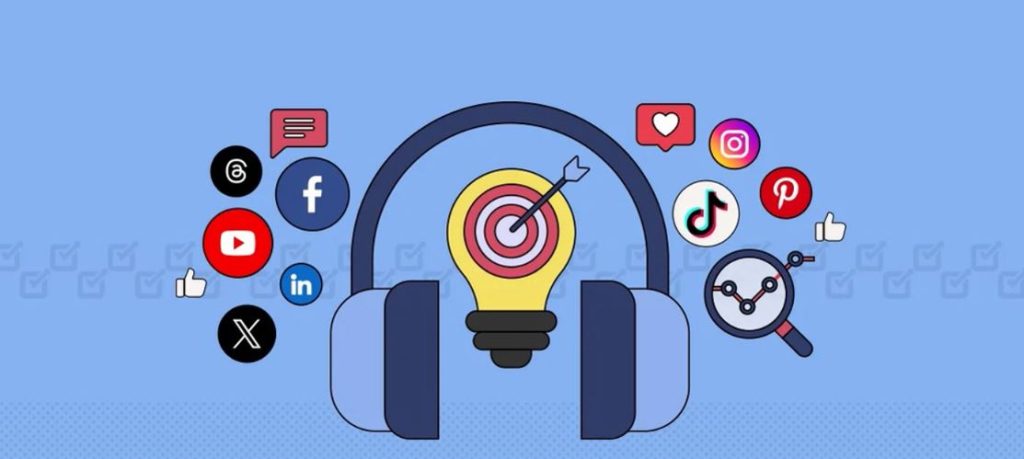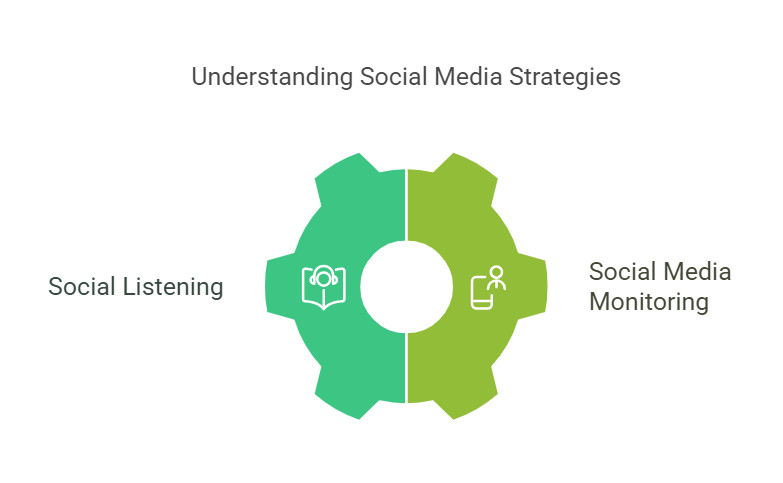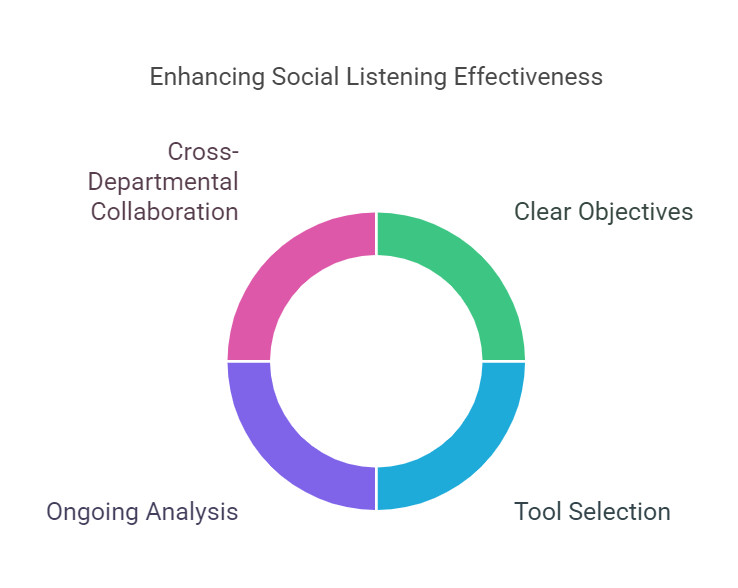- Research platform
Sources of information
Data analysis
Actions
- Solutions
For whom
Problems / Issues
- Materials
Materials
- About us
About us

Today, in a fast digital world, social listening is a key tactic for brands trying to connect with audiences. But what is social listening, and why does it matter? Essentially, social listening involves monitoring and analyzing conversations about your brand across social media platforms. This method goes beyond monitoring; it helps brands gather insights into customer feelings, preferences, and trends.
Developing a robust social listening strategy is essential for brands to effectively understand and engage with their audience.
This blog looks at the definition and importance of social listening. You will learn how this technique can change your marketing approach. You’ll see how social listening differs from social media monitoring, find out benefits it provides, and learn how to implement effective strategies. Additionally, we will introduce tools and metrics to boost your social listening efforts. Whether you are an experienced marketer or a business owner aiming to improve your brand presence, grasping social listening is vital to staying relevant in today’s conversation.
Social listening, also known as social media listening, refers to monitoring social media to get insight about discussions around a brand, rivals, and the industry. This method tracks conversations and comments to gauge customer sentiment, market trends, and brand perception. By focusing on what audiences say online, companies gather insights that shape their business strategies. Utilizing social media listening tools enables businesses to track mentions, gather insights about customer preferences, and identify trends.
A crucial part of social listening is gaining customer insights and feedback that can often be missed. This allows organizations to quantify customer satisfaction, spot emerging issues, and understand their brand standing against competitors. This approach helps brands stay agile and relevant to audience needs.
The relevance of social listening increases in today’s digital world. With around 4.7 billion social media users, businesses access vast data about customer opinions. Analyzing this data reveals patterns that influence brand strategies and marketing efforts. Plus, social listening helps uncover insights on products, target customers, and market dynamics.
Moreover, social listening drives customer engagement and loyalty. Brands that listen and act on feedback show dedication to customer satisfaction. Those feeling heard are likelier to be loyal and promote the brand, boosting growth through positive word-of-mouth. In today’s market, this relationship is necessary, with 70% of consumers favoring brands engaging on social media.
In conclusion, social listening is more than just monitoring conversations. It is a vital strategy that lets businesses align their operations with audience needs. Understanding customer sentiment and the competitive environment through social listening enables brands to innovate, improve offers, and tailor messaging for effective impact.

In digital marketing, knowing the difference between social listening and social media monitoring is important for any brand looking to engage customers and manage sentiment effectively. Both practices are vital for insights from social media, but they have different objectives.
Social listening takes a proactive approach. It looks at broader topics, trends, and feelings related to a brand or its industry. Brands that use social listening examine conversations beyond direct product mentions. For example, a company can gauge how audiences view industry trends, activities of competitors, and new topics that come up. This gives insights into customer needs and preferences.
In contrast, social media monitoring reacts to direct interactions, mentions, and engagement with the brand. This involves tracking mentions, customer comments, and inquiries on social platforms. Social media monitoring tools are essential for tracking mentions, customer comments, and inquiries on social platforms, enabling brands to respond quickly and manage their online reputation. Such an approach helps brands reply quickly to customer questions and manage online reputation. For instance, spotting an increase in negative sentiments regarding a product launch helps brands address issues quickly.
Grasping the difference between social listening and social media monitoring allow brands to select the right tactics based on their objectives and resources available. Brands focusing on social listening gain insights into potential market shifts and can innovate based on consumer feedback. Others who emphasize social media monitoring build strong relationships with customers through quick responses.
By mastering social listening and social media monitoring, businesses enhance their strategies. Insights from social listening can guide product development and marketing efforts. Meanwhile, social media monitoring helps improve customer loyalty and satisfaction. Engaging effectively with customers builds a strong brand presence online.
Social listening is a useful tool. It provides many benefits for businesses that want to enhance connections with customers. By monitoring feedback across various platforms, brands can gain insights. These insights drive growth and engagement.
In summary, the benefits of social listening cover many business aspects. They enhance customer engagement while influencing strategic decisions. Harnessing social listening helps companies to build strong audience relationships while remaining competitive.
The next section will examine strategies for effective social listening. Implement these to maximize business growth and harness its full potential.
Social listening can be a powerful tool for business intelligence, providing valuable insights into customer behavior, market trends, and competitor activity. By monitoring relevant conversations on social media, businesses can gain a deeper understanding of their target audience, identify new opportunities, and stay ahead of the competition.
One of the key benefits of social listening for business intelligence is its ability to provide real-time data and insights. Unlike traditional market research methods, which can be time-consuming and expensive, social listening allows businesses to tap into the conversations that are happening right now. This can be particularly useful for businesses that operate in fast-paced industries, where staying ahead of the curve is crucial.
Another benefit of social listening for business intelligence is its ability to provide a more nuanced understanding of customer behavior. By analyzing social media conversations, businesses can gain a deeper understanding of their customers’ needs, preferences, and pain points. This can be used to inform product development, marketing strategies, and customer service initiatives.
To use social listening for business intelligence, businesses can start by identifying relevant keywords and hashtags related to their industry or target audience. They can then use social listening tools to monitor these conversations and analyze the data for insights. This can be done manually, or through the use of automated tools and software.
Some of the key metrics that businesses can track through social listening include:
By tracking these metrics, businesses can gain a deeper understanding of their target audience, identify new opportunities, and stay ahead of the competition. Social listening tools can help streamline this process, making it easier to gather and analyze social media data effectively.

Brands need clear objectives for social listening. These goals align with marketing and business aims. They might include boosting customer satisfaction or improving brand reputation. Specific, measurable aims help track social listening success over time. A well-defined social media strategy informed by social listening can significantly enhance customer satisfaction and brand reputation.
Choosing the correct tools is vital to gather data effectively. Numerous social listening tools exist, each with unique features. Brands must prioritize tools that analyze various social media channels and offer real-time insights. A tool must allow data filtering to highlight actionable insights.
Ongoing analysis based on social listening insights is important. Regularly reviewing data helps find trends, sentiment changes, or new topics. This analysis gives brands the ability to change strategies quickly based on audience reactions.
Working together across departments improves the use of social listening insights. When marketing, customer service, and product teams collaborate, they make better use of social listening data. Customer service can use feedback to fix common issues while marketing can adjust campaigns to better connect with the audience.
In conclusion, social listening requires continuous effort. It is not a one-time project. Setting clear objectives, using the right tools, analyzing data constantly, and collaborating across departments enhances social listening effectiveness. This leads to better customer relations and performance for businesses.
Looking ahead, it is vital to examine the tools and metrics essential for effective social listening. Picking the right tools improves implementation and strengthens the accuracy of insights gained.
Effective social listening greatly depends on selecting the right social media listening tools and metrics for data analysis. The right tech streamline the process of gathering and analyzing vast amounts of information on social media platforms. This helps businesses understand their audience better.
Businesses can improve their understanding of consumer behaviors and preferences through advanced social listening tools and consistently measuring relevant metrics. This leads to more informed decision-making and better customer engagement strategies.
In short, social listening serves as an crucial resource. It extends beyond basic social media tracking. Brands can engage in discussions relevant to them. Gaining insights into customer preferences, feelings and trends is invaluable. We reviewed its role in aid of customer relations, product progress and better marketing plans.
Understanding now the uses and rewards of social listening, the next step is action. Start by spotting dialogues on your brand or within the sector. Use tools mentioned to collect insights, assess how you’re doing, and adjust your plans as necessary. Social listening provides more than trends. It’s vital for brands to succeed in the digital world.
As you start this path, remember that mastering social listening can lead to engagement that matters and fuel success. Adopt this method to discover choices that will move your brand ahead.
Copyright © 2023. YourCX. All rights reserved — Design by Proformat